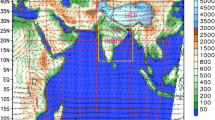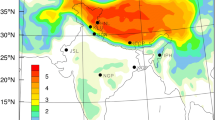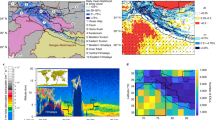Abstract
The role of aerosol on the snow darkening effect is considered one of the main factors contributing to snow melting and glacier retreat over the Himalayas and Tibetan Plateau (HTP). Using the International Centre for Theoretical Physics (ICTP)’s regional climate model, RegCM4, we examine the changes induced by aerosol deposition over the HTP snow and its dynamical impacts over northern India during the pre-monsoon season (March to June), which is critical for the inception and development of the monsoon. Sensitivity experiments with and without aerosol-induced snow darkening effects for the period 2006–2010 reveal that this effect causes a significant reduction of snow cover fraction by 10 to 15% and an increase in surface temperatures (> 4 °C), which improves the model performance when comparing against observations over the HTP. This response is dominated by dust deposition, which covers a larger area of the HTP compared to the black carbon. While incorporating aerosol-induced snow darkening effect, the precipitation decreases (~ 0.4–2 mm/day) over northern India due to intrusion of dry winds, which also enhance dust emissions over the Thar Desert. As a result of the decrease in precipitation, surface temperature increases and generates a low-pressure system over northern India, which further strengthens the dust transport and its burden. We also find decreases in precipitation extremes and increases in the number of consecutive dry days and extreme temperature conditions over northern India, implying strong links with changes in pre-monsoon dynamics. The aerosol-induced snow darkening effect thus facilitates an earlier monsoon onset over southern India, but the northward propagation of the precipitation band is limited by the enhanced northwesterly winds over the Indo-Gangetic Plain.



taken from TRMM for precipitation and MODIS for snow fraction during the pre-monsoon (March to June) for the period 2006–2010. The green slant lines represent regions with 95% significance level










Similar content being viewed by others
Data availability
All the ICBC and anthropogenic aerosol emission data used to run the model are archived in http://clima-dods.ictp.it/data/regcm4/. The model simulated data can be made available from the corresponding author on reasonable request.
Code availability
The RegCM model code can be downloaded from https://github.com/ictp-esp/RegCM/releases.
References
Ajay P, Pathak B, Solmon F et al (2019) Obtaining best parameterization scheme of RegCM 4.4 for aerosols and chemistry simulations over the CORDEX South Asia. Clim Dyn 53:329–352. https://doi.org/10.1007/s00382-018-4587-3
Albrecht BA (1989) Aerosols, Cloud Microphysics, and Fractional Cloudiness. Science 245:1227–1230. https://doi.org/10.1126/science.245.4923.1227
Aloysius M, Sijikumar S, Prijith S et al (2011) Role of dynamics in the advection of aerosols over the Arabian Sea along the west coast of peninsular India during pre-monsoon season: A case study based on satellite data and regional climate model. J Earth Syst Sci 120:269–279. https://doi.org/10.1007/s12040-011-0051-z
Ashfaq M, Cavazos T, Reboita MS et al (2020) Robust late twenty-first century shift in the regional monsoons in RegCM-CORDEX simulations. Clim Dyn. https://doi.org/10.1007/s00382-020-05306-2
Bollasina MA, Ming Y, Ramaswamy V (2011) Anthropogenic aerosols and the weakening of the south asian summer monsoon. Science (80- ) 334:502–505. https://doi.org/10.1126/science.1204994
Bond TC, Doherty SJ, Fahey DW et al (2013) Bounding the role of black carbon in the climate system: A scientific assessment. J Geophys Res Atmos 118:5380–5552. https://doi.org/10.1002/jgrd.50171
Coppola E, Sobolowski S, Pichelli E et al (2020) A first-of-its-kind multi-model convection permitting ensemble for investigating convective phenomena over Europe and the Mediterranean. Clim Dyn 55:3–34. https://doi.org/10.1007/s00382-018-4521-8
Chen X, Liu Y (2017) Wu, G (2017) Understanding the surface temperature cold bias in CMIP5 AGCMs over the Tibetan Plateau. Adv Atmos Sci 34:1447–1460. https://doi.org/10.1007/s00376-017-6326-9
Dagsson-Waldhauserova P, Meinander O (2019) Editorial: Atmosphere—Cryosphere Interaction in the Arctic, at High Latitudes and Mountains With Focus on Transport, Deposition, and Effects of Dust, Black Carbon, and Other Aerosols. Front Earth Sci 7:1–4. https://doi.org/10.3389/feart.2019.00337
Das S, Dey S, Dash SK, Basil G (2013) Examining mineral dust transport over the Indian subcontinent using the regional climate model, RegCM4.1. Atmos Res 134. doi: https://doi.org/10.1016/j.atmosres.2013.07.019
Das S, Dey S, Dash SK et al (2015) Dust aerosol feedback on the Indian summer monsoon: Sensitivity to absorption property. J Geophys Res 120. https://doi.org/10.1002/2015JD023589
Das S, Giorgi F, Giuliani G et al (2020a) Near-Future Anthropogenic Aerosol Emission Scenarios and Their Direct Radiative Effects on the Present-Day Characteristics of the Indian Summer Monsoon. J Geophys Res Atmos 125. https://doi.org/10.1029/2019JD031414
Das S, Giorgi F, Giuliani G (2020b) Investigating the relative responses of regional monsoon dynamics to snow darkening and direct radiative effects of dust and carbonaceous aerosols over the Indian subcontinent. Clim Dyn 55. https://doi.org/10.1007/s00382-020-05307-1
Dee DP, Uppala SM, Simmons AJ et al (2011) The ERA-Interim reanalysis: Configuration and performance of the data assimilation system. Q J R Meteorol Soc 137:553–597. https://doi.org/10.1002/qj.828
Dey S, Di Girolamo L (2010) A climatology of aerosol optical and microphysical properties over the Indian subcontinent from 9 years (2000–2008) of Multiangle Imaging Spectroradiometer (MISR) data. J Geophys Res Atmos 115:1–22. https://doi.org/10.1029/2009JD013395
Dey S, Tripathi SN, Singh RP, Holben BN (2004) Influence of dust storms on the aerosol optical properties over the Indo-Gangetic basin. J Geophys Res D Atmos 109:1–13. https://doi.org/10.1029/2004JD004924
Dumka UC, Kaskaoutis DG, Francis D, Chaboureau JP, Rashki A, Tiwari S et al (2019) The role of the Intertropical Discontinuity region and the heat low in dust emission and transport over the Thar desert, India: A premonsoon case study. Journal of Geophysical Research: Atmospheres 124:13197–13219. https://doi.org/10.1029/2019JD030836
Emanuel K, Zivkovic-Rothman M (2000) Comments on “Development and Evaluation of a Convection Scheme for Use in Climate Models.” J Atmos Sci 57:36863686. https://doi.org/10.1175/15200469(2000)057%3c3686:codaeo%3e2.0.co;2
Fan J, Wang Y, Rosenfeld D, Liu X (2016) Review of aerosol-cloud interactions: Mechanisms, significance, and challenges. J Atmos Sci 73:4221–4252. https://doi.org/10.1175/JAS-D-16-0037.1
Flanner MG, Zender CS, Hess PG et al (2009) Springtime warming and reduced snow cover from carbonaceous particles. Atmos Chem Phys 9:2481–2497. https://doi.org/10.5194/acp-9-2481-2009
Flanner MG, Zender CS, Randerson JT, Rasch PJ (2007) Present-day climate forcing and response from black carbon in snow. J Geophys Res Atmos 112:1–17. https://doi.org/10.1029/2006JD008003
Gadhavi HS, Renuka K, Ravi Kiran V et al (2015) Evaluation of black carbon emission inventories using a Lagrangian dispersion model - A case study over southern India. Atmos Chem Phys 15:1447–1461. https://doi.org/10.5194/acp-15-1447-2015
Giorgi F, Jones C, Asrar G (2009) Addressing climate information needs at the regional level: The CORDEX framework. WMO Bulletin 58:175–183
Giorgi F, Coppola E, Solmon F et al (2012) RegCM4: Model description and preliminary tests over multiple CORDEX domains. Clim Res 52:7–29. https://doi.org/10.3354/cr01018
Giorgi F, Bi X, Qian Y (2002) Direct radiative forcing and regional climatic effects of anthropogenic aerosols over East Asia: A regional coupled climate-chemistry/aerosol model study. J Geophys Res Atmos 107:AAC 7–1-AAC 7–18. doi: https://doi.org/10.1029/2001JD001066
Giorgi F (2019) Thirty Years of Regional Climate Modeling: Where Are We and Where Are We Going next? J Geophys Res Atmos 124:5696–5723. https://doi.org/10.1029/2018JD030094
Grenier H, Bretherton CS (2001) A moist PBL parameterization for large-scale models and its application to subtropical cloud-topped marine boundary layers. Mon Weather Rev 129:357–377. https://doi.org/10.1175/1520-0493(2001)129%3c0357:AMPPFL%3e2.0.CO;2
Guo L, Turner AG, Highwood EJ (2016) Local and remote impacts of aerosol species on indian summer monsoon rainfall in a GCM. J Clim 29:6937–6955. https://doi.org/10.1175/JCLI-D-15-0728.1
Hall DK, Riggs GA (2007) Assessment of Errors in the MODIS Suite of Snow-Cover Products. Hyrol Process 21:1534–1547
Harris I, Osborn TJ, Jones P, Lister D (2020) Version 4 of the CRU TS monthly high-resolution gridded multivariate climate dataset. Sci Data 7:1–18. https://doi.org/10.1038/s41597-020-0453-3
He C, Takano Y, Liou KN et al (2017) Impact of snow grain shape and black carbon-snow internal mixing on snow optical properties: Parameterizations for climate models. J Clim 30:10019–10036. https://doi.org/10.1175/JCLI-D-17-0300.1
He C, Flanner MG, Chen F et al (2018) Black carbon-induced snow albedo reduction over the Tibetan Plateau: Uncertainties from snow grain shape and aerosol-snow mixing state based on an updated SNICAR model. Atmos Chem Phys 18:11507–11527. https://doi.org/10.5194/acp-18-11507-2018
Hu Z, Huang J, Zhao C et al (2020) Modeling dust sources, transport, and radiative effects at different altitudes over the Tibetan Plateau. Atmos Chem Phys 20:1507–1529. https://doi.org/10.5194/acp-20-1507-2020
Huffman GJ, Adler RF, Bolvin DT, Nelkin EJ (2010) The TRMM Multi-Satellite Precipitation Analysis (TMPA) In: Satellite rainfall applications for surface hydrology. Satell. Rainfall Appl. Surf. Hydrol., 1–327, https://doi.org/10.1007/978-90-481-2915-7.
Ji Z, Kang S, Cong Z et al (2015) Simulation of carbonaceous aerosols over the Third Pole and adjacent regions: distribution, transportation, deposition, and climatic effects. Clim Dyn 45:2831–2846. https://doi.org/10.1007/s00382-015-2509-1
Kang L, Huang J, Chen S, Wang X (2016) Long-term trends of dust events over Tibetan Plateau during 1961–2010. Atmos Environ 125:188–198. https://doi.org/10.1016/j.atmosenv.2015.10.085
Kiehl JT, Hack JJ, Bonan GB, et al (1996) Description of the NCAR Community Climate Model (CCM3). NCAR Tech Note NCAR/TN-420+STR 159
Kumar R, Barth MC, Pfister GG et al (2014) WRF-Chem simulations of a typical pre-monsoon dust storm in northern India: Influences on aerosol optical properties and radiation budget. Atmos Chem Phys 14:2431–2446. https://doi.org/10.5194/acp-14-2431-2014
Lau KM, Kim KM (2006) Observational relationships between aerosol and Asian monsoon rainfall, and circulation. Geophys Res Lett 33:1–5. https://doi.org/10.1029/2006GL027546
Lau KM, Kim MK, Kim KM (2006) Asian summer monsoon anomalies induced by aerosol direct forcing: The role of the Tibetan Plateau. Clim Dyn 26:855–864. https://doi.org/10.1007/s00382-006-0114-z
Lau WKM, Kim KM (2018) Impact of snow darkening by deposition of light-absorbing aerosols on snow cover in the Himalayas-Tibetan Plateau and influence on the Asian summer monsoon: A possible mechanism for the blanford hypothesis. Atmosphere (basel) 9. https://doi.org/10.3390/atmos9110438
Lee WL, Liou KN, He C et al (2017) Impact of absorbing aerosol deposition on snow albedo reduction over the southern Tibetan plateau based on satellite observations. Theor Appl Climatol 129:1373–1382. https://doi.org/10.1007/s00704-016-1860-4
Levy RC, Mattoo S, Munchak LA et al (2013) The Collection 6 MODIS aerosol products over land and ocean. Atmos Meas Tech 6:2989–3034. https://doi.org/10.5194/amt-6-2989-2013
Liu Z (2015) Evaluation of precipitation climatology derived from TRMM multi-satellite precipitation analysis (TMPA) monthly product over land with two gauge-based products. Climate 3:964–982. https://doi.org/10.3390/cli3040964
Li Z, Lau WKM, Ramanathan V et al (2016) Aerosol and monsoon climate interactions over Asia. Rev Geophys 54:866–929. https://doi.org/10.1002/2015RG000500
Maharana P, Dimri AP, Choudhary A (2019) Redistribution of Indian summer monsoon by dust aerosol forcing. Meteorol Appl 26:584–596. https://doi.org/10.1002/met.1786
Ming J, Wang P, Zhao S, Chen P (2013) Disturbance of light-absorbing aerosols on the albedo in a winter snowpack of Central Tibet. J Environ Sci (China) 25:1601–1607. https://doi.org/10.1016/S1001-0742(12)60220-4
Nair VS, Solmon F, Giorgi F et al (2012) Simulation of South Asian aerosols for regional climate studies. J Geophys Res Atmos 117:1–17. https://doi.org/10.1029/2011JD016711
Ojha N et al (2020) On the widespread enhancement in fine particulate matter across the Indo-Gangetic Plain towards winter. Sci Rep 10:1–9. https://doi.org/10.1038/s41598-020-62710-8
Oleson KW, Lawrence DM, Bonan GB, et al (2013) CLM 4.5 NCAR Technical Note. NCAR Tech Note
Pal JS, Small EE, Eltahir EAB (2000) Simulation of regional-scale water and energy budgets: Representation of subgrid cloud and precipitation processes within RegCM. J Geophys Res Atmos 105:29579–29594. https://doi.org/10.1029/2000JD900415
Panicker AS, Pandithurai G, Dipu S (2010) Aerosol indirect effect during successive contrasting monsoon seasons over Indian subcontinent using MODIS data. Atmos Environ 44:1937–1943. https://doi.org/10.1016/j.atmosenv.2010.02.015
Pattnayak KC, Panda SK, Saraswat V, Dash SK (2016) Relationship between tropospheric temperature and Indian summer monsoon rainfall as simulated by RegCM3. Clim Dyn 46:3149–3162. https://doi.org/10.1007/s00382-015-2758-z
Pradhan M, Rao AS, Srivastava A, Dakate A, Salunke K, Shameera KS (2017) Prediction of Indian Summer-Monsoon Onset Variability: A Season in Advance. Sci Rep 7:1–14. https://doi.org/10.1038/s41598-017-12594-y
Qian Y, Flanner MG, Leung LR, Wang W (2011) Sensitivity studies on the impacts of Tibetan Plateau snowpack pollution on the Asian hydrological cycle and monsoon climate. Atmos Chem Phys 11:1929–1948. https://doi.org/10.5194/acp-11-1929-2011
Ramanathan V, et al (2005) Atmospheric brown clouds: Impacts on South Asian climate and hydrological cycle. Proc Natl Acad Sci U S A 102:5326–5333. https://doi.org/10.1073/pnas.0500656102
Rana A, Nikulin G, Kjellström E et al (2020) Contrasting regional and global climate simulations over South Asia. Clim Dyn 54:2883–2901. https://doi.org/10.1007/s00382-020-05146-0
Sanjay J, Krishnan R, Shrestha AB et al (2017) Downscaled climate change projections for the Hindu Kush Himalayan region using CORDEX South Asia regional climate models. Adv Clim Chang Res 8:185–198. https://doi.org/10.1016/j.accre.2017.08.003
Sarangi C, Qian Y, Rittger K et al (2018) Impact of light-absorbing particles on snow albedo darkening and associated radiative forcing over High Mountain Asia: High resolution WRF-Chem modeling and new satellite observations. Atmos Chem Phys Discuss 1–56. https://doi.org/10.5194/acp-2018-979
Sarangi C, Qian Y, Rittger K, Leung LR, Chand D, Bormann KJ, Painter TH (2020) Dust dominates high-altitude snow darkening and melt over high-mountain Asia. Nat Clim Chang 10:1045–1105. https://doi.org/10.1038/s41558-020-00909-3
Sarkar S, Chauhan A, Kumar R, Singh RP (2019) Impact of Deadly Dust Storms (May 2018) on Air Quality, Meteorological, and Atmospheric Parameters Over the Northern Parts of India. GeoHealth 3:67–80. https://doi.org/10.1029/2018gh000170
Schmale J, Flanner M, Kang S et al (2017) Modulation of snow reflectance and snowmelt from Central Asian glaciers by anthropogenic black carbon. Sci Rep 7:1–10. https://doi.org/10.1038/srep40501
Sharma D, Singh D, Kaskaoutis DG (2012) Impact of two intense dust storms on aerosol characteristics and radiative forcing over Patiala. Northwestern India Adv Meteorol 2012. https://doi.org/10.1155/2012/956814
Shi Z, Xie X, Li X et al (2018) Snow-darkening versus direct radiative effects of mineral dust aerosol on the Indian summer monsoon: role of the Tibetan Plateau. Atmos Chem Phys Discuss 1–29. https://doi.org/10.5194/acp-2018-471
Solmon F, Giorgi F, Liousse C (2006) Aerosol modelling for regional climate studies: Application to anthropogenic particles and evaluation over a European/African domain. Tellus, Ser B Chem Phys Meteorol 58:51–72. https://doi.org/10.1111/j.1600-0889.2005.00155.x
Srivastava AK, Tiwari S, Devara PCS et al (2011) Pre-monsoon aerosol characteristics over the Indo-Gangetic Basin: Implications to climatic impact. Ann Geophys 29:789–804. https://doi.org/10.5194/angeo-29-789-2011
Stohl A, Aamaas B, Amann M et al (2015) Evaluating the climate and air quality impacts of short-lived pollutants. Atmos Chem Phys 15:10529–10566. https://doi.org/10.5194/acp-15-10529-2015
Swenson SC, Lawrence DM (2012) A new fractional snow-covered area parameterization for the Community Land Model and its effect on the surface energy balance. J Geophys Res 117:D21107. https://doi.org/10.1029/2012JD018178
Tiedtke M (1989) A Comprehensive Mass Flux Scheme for Cumulus Parameterization in Large-Scale Models. Mon Weather Rev 117:1779–1800
Tiwari PR, Kar SC, Mohanty UC et al (2016) On the dynamical downscaling and bias correction of seasonal-scale winter precipitation predictions over North India. Q J R Meteorol Soc 142:2398–2410. https://doi.org/10.1002/qj.2832
Twomey S (1974) Pollution and the planetary albedo. Atmos Environ 8:1251–1256
Usha KH, Nair VS, Babu SS (2020) Modeling of aerosol induced snow albedo feedbacks over the Himalayas and its implications on regional climate. Clim Dyn 54:4191–4210. https://doi.org/10.1007/s00382-020-05222-5
Usha KH, Nair VS, Babu SS, (2021) Effect of aerosol-induced snow darkening on the direct radiative effect of aerosols over the Himalayan region. Environ. Res. Lett (accepted).
Wang C (2013) Impact of anthropogenic absorbing aerosols on clouds and precipitation: A review of recent progresses. Atmos Res 122:237–249. https://doi.org/10.1016/j.atmosres.2012.11.005
Xie X, Liu X, Che H et al (2018) Radiative feedbacks of dust in snow over eastern Asia in CAM4-BAM. Atmos Chem Phys 18:12683–12698. https://doi.org/10.5194/acp-18-12683-2018
Xu C, Ma Y, Yang K, You C (2018) Tibetan Plateau impacts on global dust transport in the upper troposphere. J Clim 31:4745–4756. https://doi.org/10.1175/JCLI-D-17-0313.1
Yasunari TJ, Tan Q, Lau KM et al (2014) Estimated range of black carbon dry deposition and the related snow albedo reduction over Himalayan glaciers during dry pre-monsoon periods. Atmos Environ 78:259–267. https://doi.org/10.1016/j.atmosenv.2012.03.031
Zakey AS, Solmon F, Giorgi F (2006) Development and testing of a desert dust module in a regional climate model. Atmos Chem Phys Discuss 6:1749–1792. https://doi.org/10.5194/acpd-6-1749-2006
Zakey AS, Giorgi F, Bi X (2008) Modeling of sea salt in a regional climate model: Fluxes and radiative forcing. J Geophys Res Atmos 113:1–27. https://doi.org/10.1029/2007JD009209
Zender CS, Bian H, Newman D (2003) Mineral Dust Entrainment and Deposition (DEAD) model: Description and 1990s dust climatology. J Geophys Res Atmos 108. https://doi.org/10.1029/2002jd002775
Zhang R, Wang H, Qian Y et al (2015) Quantifying sources, transport, deposition, and radiative forcing of black carbon over the Himalayas and Tibetan Plateau. Atmos Chem Phys 15:6205–6223. https://doi.org/10.5194/acp-15-6205-2015
Acknowledgements
We thank the anonymous reviewers for the constructive comments that improved the quality of the manuscript. The authors are thankful to the supercomputing facility provided by Marconi installed in CINECA machine and Argo at ICTP, where all the simulations and initial model tuning were carried out respectively. ICTP’s RegCM4 model is freely available online in https://github.com/ictp-esp/RegCM/releases. The anthropogenic aerosol emissions considered for baseline and mitigation of SLCPs are taken from ECLIPSE data inventory.
The data can be accessed from an online website clicking the following link http://www.iiasa.ac.at/web/home/research/researchPrograms/air/ECLIPSEv5a.html. The lateral boundary conditions and topographical data can be downloaded from http://clima-dods.ictp.it/data/regcm4/. All the observation data sources are highly acknowledged. The first author is thankful to the UN-ICTP’s postdoctoral fellowship for carrying out the research. A.S. Panicker and A.S. Gautam acknowledge ICTP, Italy, for Junior Associateship for collaborative research. VSN acknowledges SwarnaJayanti Fellowship of DST, Govt. of India.
Author information
Authors and Affiliations
Contributions
SD and FG conceptualized the research. SD, FG, and EC customized the RegCM model over the region of study. SD performed the model simulations with the inputs from EC, VSN, and GG. ASP and ASG helped in analyzing the model results. All the authors contributed in writing, analyzing, and finalizing the manuscript.
Corresponding author
Ethics declarations
Ethics approval
All the authors comply with the guidelines of the journal Theoretical and Applied Climatology.
Consent to participate
All the authors agreed to participate in this study.
Consent for publication
All the authors agreed to the publication of this study.
Conflict of interest
The authors declare no competing interests.
Additional information
Publisher's note
Springer Nature remains neutral with regard to jurisdictional claims in published maps and institutional affiliations.
Supplementary Information
Below is the link to the electronic supplementary material.
Rights and permissions
About this article
Cite this article
Das, S., Giorgi, F., Coppola, E. et al. Linkage between the absorbing aerosol-induced snow darkening effects over the Himalayas-Tibetan Plateau and the pre-monsoon climate over northern India. Theor Appl Climatol 147, 1033–1048 (2022). https://doi.org/10.1007/s00704-021-03871-y
Received:
Accepted:
Published:
Issue Date:
DOI: https://doi.org/10.1007/s00704-021-03871-y




